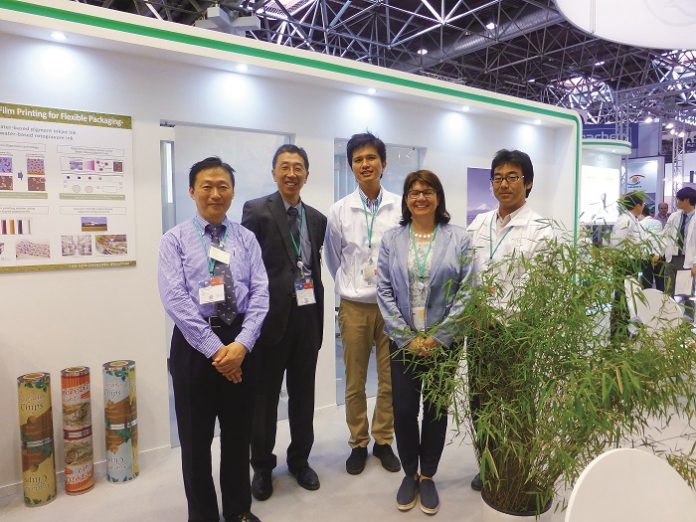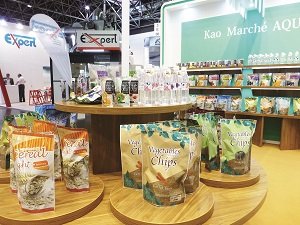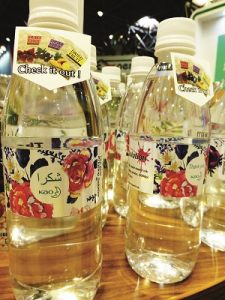
‘Eco-friendly’ printing is now possible says Japanese chemicals company Kao Corporation, a drupa first-timer who has introduced the ‘world’s first’ VOC-free, water-based ink technology for industrial inkjet printing aimed at the food packaging films sector. In addition to being ‘non-reactive and non-hazardous,’ good jetting and stability are key factors in a development that sprang from a water-based enamel for nail varnish that Kao has been producing for 15 years.
 Senior manager and inkjet team leader for imaging materials Shinji Moriyama showed Packaging South Asia close-up examples of 5-color reverse printing using the new nano-based polymer and dispersion technology on OPP and PET which is laminated with a non-solvent material. Meanwhile fine displays of converted labels and pouches let visitors appreciate the quality and colorful impact of finished products.
Senior manager and inkjet team leader for imaging materials Shinji Moriyama showed Packaging South Asia close-up examples of 5-color reverse printing using the new nano-based polymer and dispersion technology on OPP and PET which is laminated with a non-solvent material. Meanwhile fine displays of converted labels and pouches let visitors appreciate the quality and colorful impact of finished products.
Kao’s nano-dispersion pigment technology involves functional polymers that encapsulate the nano-sized pigments and this allows a water-based pigment inkjet ink to print VOC-free on film materials, avoiding the need to recycle solvent and for special fire safety measures. Think Laboratories and Kao worked together on the technology for inkjet printing systems exclusively for water-based ink, and the FXIJ-1 Aqua line head printer is due to launch at the end of this year. The achievable running speed at drupa was 20 metres a minute, but a target of 30 metres a minute is expected by this October, in time for Tokyo Pack, the major packaging industry show for the Asia region. Moriyama also reported that beta-testing had been commissioned in Japan with a middle-sized food packaging supplier.

The same technology is suitable for water-based rotogravure ink for VOC-free production of high quality images says Kao. In cooperation with Think Laboratories and Seikou Co, Kao is able to provide a water-based ink with high dispersion stability and which can achieve high print density, quality and gloss without dilution using an organic solvent. Engraving depth can be reduced from a typical 14 microns, to just 5 microns, because less ink is required to produce a color effect that is comparable with a standard ink technology and a small amount of pigment gives wide coverage, explained Moriyama.
At its drupa press conference the Kao Corporation Chemical division said it will enter the industrial printing market and target global sales of 10 billion Yen (approximately Indian Rs. 651 crore or US$ 98 million) or more by 2020. Kao Corporation with interests in fat and oil derivatives, functional polymers, surfactants and aroma chemicals and enzymes had net sales of Japanese Yen 1,471.8 billion (US$ 12.2 billion) in 2015.









